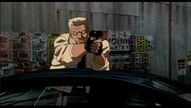To say which piece of music is best to listen to when reading a Cyberpunk novel, I think it is the Floating Museum. It can be regarded as one of the most enchanting and lonely melodies in all the works of Kenji Kawai.
Similarly, this duel at the end of the film museum is extremely cold. It's the best scene design among all the movies I've seen. Although I personally think that Mamoru Oshii and his team have never produced such a perfect work before and after "Ghost in the Shell", but only this one-I call it "the sad battle of minimalism." , Which embodies his design of the pictures, the image and action of the characters, the control of the atmosphere, and more importantly, the accuracy, simplicity and restraint of the rendering and guidance of emotions, which are enough to be worthy of the title of a master.
The raindrops falling from the roof, the broken glass, the hall of blue gloomy light, the huge and majestic tank moving in the manner of a spider, the hot bullet shell that fell into the cold water, the woman in the concealed heat mask Major Motoko’s incredible swift movements, and finally her strong mechanical body fell apart in the extremely sad music... The strange thing is that in this one-stop battle scene I felt surprisingly quiet, and the fierce confrontation seemed silent. Yes, only a physically invincible soul was extremely attracted to another soul and fell into confusion, but it was manifested in an extremely tough way.
I want to get rid of this symbolic science fiction story. The somber and tough but at the same time sensitive and sentimental atmosphere is the most successful part of "Ghost in the Shell". Before that, it was not difficult to write a Cyberpunk story on a typewriter. , But how to visualize, or perceptualize, such a concept? Oshii Mamoru was the first to do it, and he did it with unprecedented success.
When I watched this film for the first time in 1998, I was particularly surprised that it was completely different from a Matrix-like simulation world I envisioned. "Ghost in the Shell" is set in the background of "old urbanization". The Chinese characters in the eyes, the old-fashioned barge floating in the water, and the rows of yellow umbrellas across the screen in the rain gave this film an unexpected emotional sentiment. I think Mamoru Oshii, as a Japanese, is completely different from Westerners in that he realizes that it is not gorgeous imagination, incredible technology or fancy fights that manipulate this future world, but the constant conflicts between human reason and sensibility. , The emotional sadness and despair of people aroused by this conflict in the materialized world will not disperse the souls that entangle people for a long time, no matter how hard their bodies are. This contrast, the huge distance between the cold material and the stimulating sensibility, is what makes Cyberpunk so stunning. As an Asian, Mamoru Oshii used a means of expressing his sensibility: the image of a female agent with invincible body, firm will and complete loss of emotion is precisely the foreshadowing of this emotional explosion. Compared with the perceptual power of "Ghost in the Shell", the "Matrix" produced by Hollywood three years later, although it provides you with a lot of visual intent, from my personal point of view, it is still just a doping. It's just a sci-fi and philosophy story of gorgeous fights, not bad, but far inferior to the thrilling ones from "Ghost in the Shell".
When I saw the Floating Museum, I suddenly realized that the structure and internal logic of this story are not important anymore. Derived from the ideographic platform of "Ghost in the Shell", the perplexity, perplexity, perplexity, and perplexity that people always face in the spiritual world after becoming a human being are the permanent tragedy. Where is the power of sex.
Attachment:
1. I don’t know why I remembered the ending of Lust Caution, which made me feel particularly uncomfortable. If Wang Jiazhi could have such a firm will, like the female major Motoko in the Floating Museum, she would want to ignore the danger of physical destruction. The persistence of finding answers to the questions, the tone of this film will be quite different. I don’t know if this shows some differences in personalities between Chinese and Japanese?
2. It is purely my guess. Once when I watched Polanski's "Sword in the Water", I suddenly found that the long and beautiful heroine in it was very similar to the Motoko in "Ghost in the Shell" from the hairstyle to the facial features. Major. In particular, several scenes in the film are exactly the same as the action designs of some female majors in "Ghost in the Shell". I know that Mamoru Oshii was a super fan when he was young, and he had a record of watching a thousand movies in a movie theater a year. Really does not rule out the possibility of him designing Motoko's animated image in "Knife in the Water". Those who are interested can find these two films and compare them.
View more about Ghost in the Shell reviews











